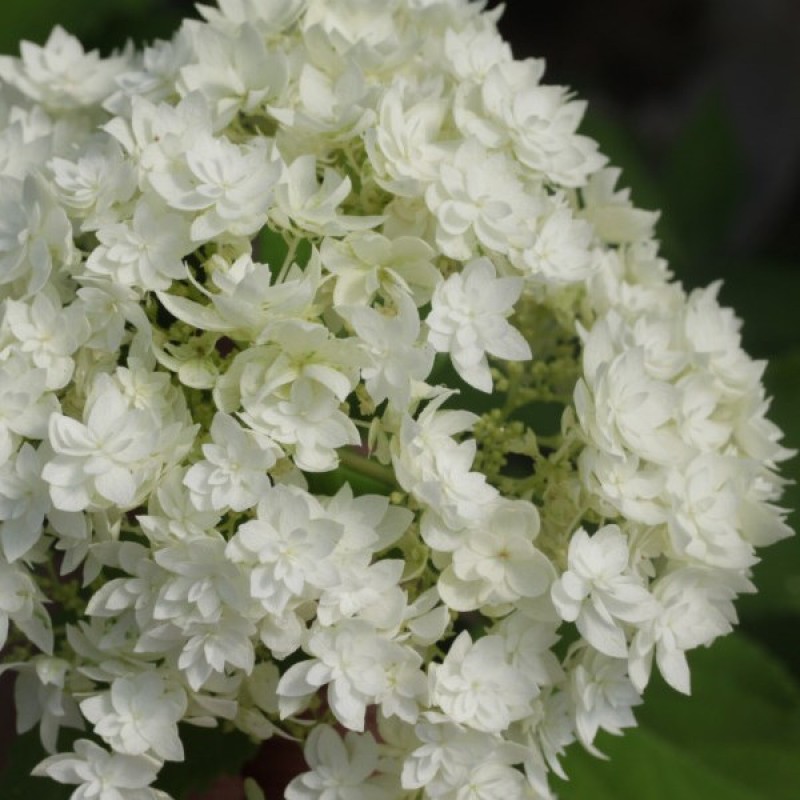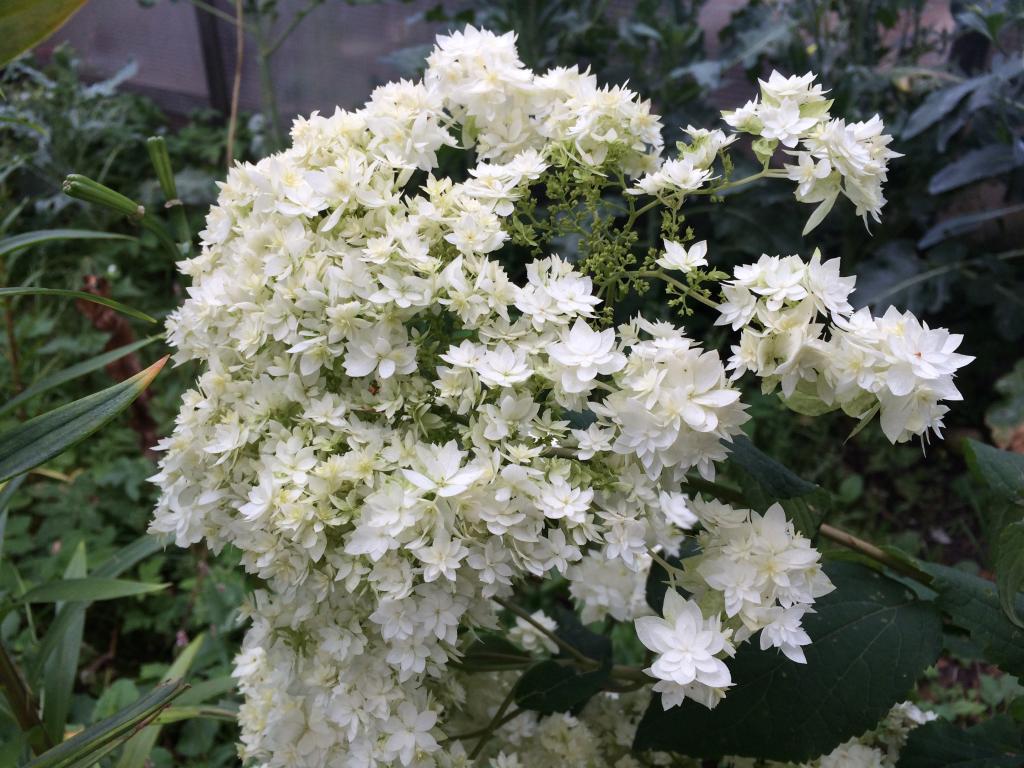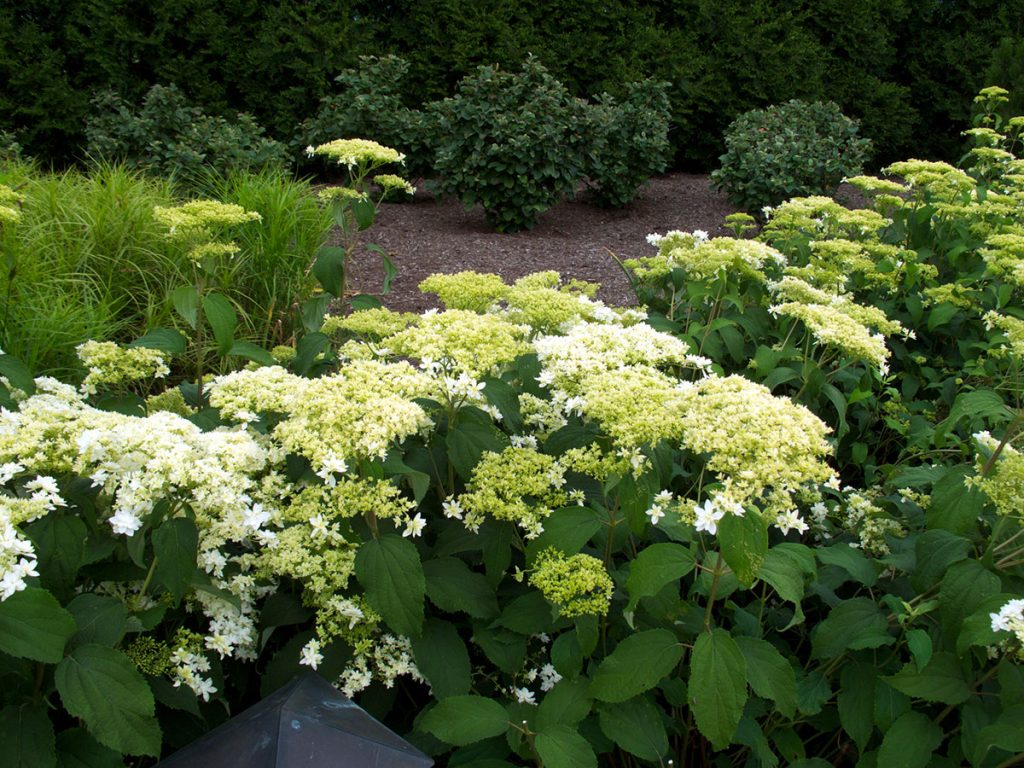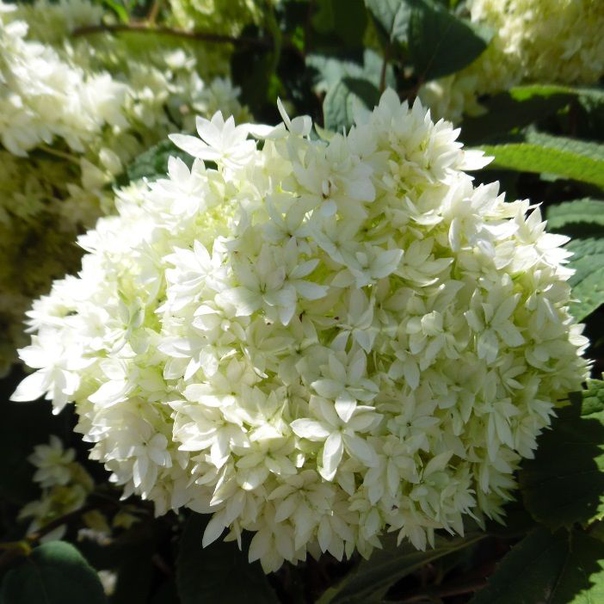Hydrangea tree Hayes Starburst - planting and care
Ornamental hydrangea Hayes Starburst belongs to the tree-like varieties with double inflorescences. In the wild, it is found in southern, eastern Asia, North America, China and Japan. Consider the main characteristic of the variety, as well as the rules for planting and caring for it.

Hydrangea hayes starburst
Description of the variety
The tree hydrangea Hayes Starburst has good frost resistance, therefore it is suitable for growing in different climatic zones of our country. It blooms for a long time - from July to the first frost.
The scientific name of the perennial culture is hydrangea hayes starburst.
Stems are erect, height - 1-1.2 m. Crown size - 1.4-1.5 m. Leaves are emerald, oblong, 10-13 cm long, with jagged edges. Dome-shaped inflorescences, 25 cm in diameter, consist of small sterile flowers, with a circumference of 3 cm.
At the beginning of flowering, the petals are light green, at the peak of decorativeness they acquire a milky or snow-white tone.
Landing rules
Decorativeness, immunity and development of the shrub depends on the timing, correctly selected planting site, soil.
The best time for disembarkation is spring (from mid-March to the second decade of April).
You should focus on weather conditions - the main thing is that the last frosts pass, the temperature reaches 10-15 ° С, and the soil warms up to 8-10 ° С.
In the south, this culture is planted not only in spring, but also in autumn - until the first half of September. 2 months before stable cold weather, the seedlings have time to take root and prepare for winter.
Seat selection
Hydrangea loves good lighting, but at lunchtime it needs shading, since the leaves and flowers quickly burn. Choose an area where the sun shines in the morning and evening.
When grown in the sun, the flowering will not be so long, if planted in the shade - the inflorescences develop pale and small.
It is better to plant in an area with a deep passage of groundwater up to 4 m. On swampy soil, the roots quickly rot and the shrub perishes.
It is important that the place is protected from the wind, under its influence the branches will bend to the ground and break off.
Priming
The soil is suitable for light, well-drained, acidic and enriched with organic matter and minerals. Can be planted on loam, after sprinkling the soil with sand or vermiculite at the rate of 20 kg per 1 m². To improve the structure of the sandy earth, the site is sprinkled with clay - 2 buckets for the same area.
The place is prepared a month before planting - all weeds, garden debris are removed, the necessary components are brought in, dug up and leveled.
Sapling selection
You can purchase planting material in any specialized nursery. Criteria for a high-quality and healthy seedling:
- age 2-3 years;
- the presence of several stems, densely covered with leaves;
- height not less than 50 cm;
- leaves and buds are juicy, fresh, saturated green color without signs of infection with diseases;
- shoots are flexible, without breaks, cracks and growths.
Choose bushes that are planted in containers or with an earthen ball. They have a better survival rate, since their root system is protected from drying out.
Before planting, the plant is removed from the container, dipped in a basin of water for several hours, then the roots are cut to 2-3 cm in length. This will stimulate the growth of new shoots after planting.
Landing technique
The process consists of several stages:
- Pits are dug out in two weeks, the approximate parameters are 60x70 cm, you should be guided by the size of the root system.
- A little drainage is poured into the bottom. A mixture of pebbles, rubble and brick chips is used.
- From above, a fertile composition of dug soil, compost (humus), turf soil is poured halfway, mixed in equal amounts. Additionally, 100 g of superphosphate, 300 g of wood ash and 50 g of potassium nitrate are added.
- The roots are lowered so that the root collar remains above the surface of the soil, covered with soil mixture to the top, tamped.
- Immediately after planting, you need to water - a consumption of 10 liters.
- At the end, mulch with a thick layer of peat or last year's manure.
When growing in groups, it is necessary to maintain a distance between seedlings - at least 3 m.
Care requirements
Hayes Starburst tree hydrangea description includes simplicity in care, so every gardener can grow it.

Hayes starburst hydrangea
Watering
In the first month after planting, the seedlings are watered every day. A bucket of water is poured under the bush - this way it will take root faster and grow.
After this time, the frequency is reduced and oriented according to the state of the ground. If it has dried out to a depth of 5-6 cm, the hydrangea needs to be moistened.
Abundant watering is necessary in early spring, before flowering, after it and in the fall, when the shrub leaves the foliage.
Use warm and settled water to avoid hypothermia, and as a result of rotting of the root system.
To keep the earth light, let moisture and oxygen pass well, after moistening, the near-trunk zone is loosened. In parallel, weeds are removed, weeded between the rows. To avoid drying out the soil and roots, add mulch from peat or humus.
The plant reacts positively to crown sprinkling, which is carried out in the evening hours. This stimulates the growth of green mass and prevents the appearance of parasites.
Top dressing
Hydrangea begins to fertilize in the third year of development, when the supply of nutrients laid down during planting runs out.
In early spring, they are fed with nitrogen preparations. This trace element stimulates the growth of roots and green mass. Two weeks before budding, they are fed with phosphorus and potassium to increase decorativeness. In the fall, compost or last year's manure is embedded in the near-trunk zone.
Some gardeners use green fertilizer - it has a beneficial effect on the growth, development and quality of hydrangea flowering. It is not difficult to prepare it - you need to fill a bucket with nettles or other greens to the top, fill it with water, leave it to insist in the sun for two days. After this time, drain the liquid, dilute with water in a ratio of 1:10. Pour 5 liters under one plant.
For quick assimilation of nutrients after feeding, the bushes are watered abundantly.
Pruning
Terry hydrangea Hayes Starburst needs regular pruning. The best time for it is early spring or late autumn after leaf fall. The main thing is to have time to do this before the start of sap flow, otherwise the bush may die.
The first haircut should be carried out in the year of planting the seedling - all branches are cut to 12-15 cm in length. Each subsequent season, they are shortened by 2-3 cm.
Manipulations are carried out using a well-sharpened and disinfected secateurs or scissors to exclude infection with infections. After the procedure, the crown is irrigated with copper sulfate.
Preparing for winter
In the first three years, the seedlings are still weak, so during frost they can easily freeze and die. To prevent this, they are sheltered a week before persistent cold weather.

Hydrangea treelike terry hayes starburst
- First, the trunk circle is mulched with peat, compost or last year's manure. Such material not only insulates, but also provides additional nutrition in the spring after the snow melts.
- The twigs are tied with twine or rope, tilted to the ground, fixed with brackets, covered with fallen leaves, sawdust on top, spruce branches or slate are laid on top.
They remove the insulation in the spring, when the above zero temperature stabilizes and the threat of return frosts has passed.
Reproduction methods
Hydrangea multiplies in several ways, subject to all the rules of this procedure, you can get several new seedlings at the same time.
By dividing the bush
With age, adult bushes slow down their growth, stop blooming magnificently. To restore their decorative effect, you can divide the plants into several parts.
This procedure is started in the spring. The shrub is watered abundantly, after an hour they are removed and, together with the roots, are lowered into a container of water to wash off the remnants of the soil. Dry, cut the rhizome into pieces with a garden shovel. For successful survival, each delenka should have 2-3 roots, one shoot with leaves and buds.
Places of cuts are sprinkled with crushed charcoal, after drying, they are seated separately.
Stem layering
A very popular and effective method that requires a flexible, healthy and long twig close to the ground. All the leaves are removed on it. Then it is lowered horizontally into the pre-dug groove. For good nutrition, sprinkle the branch with a mixture of peat, last year's manure and sand (1: 1: 1). Then moisten with warm water.
On the eve of autumn frosts, they are covered with a thick layer of fallen leaves or sawdust. Spruce branches are laid on top. Insulation will protect the layers from freezing in winter.
In the spring, when the snow thaws, the last frosts will pass, the shoot is dug up, cut off from the bush, and divided into several parts with shears with roots. They are planted in the same way as purchased seedlings.
Cuttings
Harvesting of planting material is carried out in the spring. Green shoots of the current year 15-20 cm long are cut on strong lignified stems. They should have leaves and buds.
In the lower part, the leaves are cut off, dipped in Kornevin's solution for an hour. After this time, they are planted in a loose mixture of sand and peat to a depth of 3 cm.
To make them take root faster, they are covered with a transparent film, ventilated every day and moistened as necessary.
After about 2-3 weeks, new leaves will appear on the shoots - a sign of successful rooting. The shelter is removed, they continue to look after, and only a month later, when the seedlings are overgrown with roots, are they planted in open ground.
Diseases and pests
The Hayes Starburst tree hydrangea has several diseases and parasites, which, if untreated, can provoke not only a loss of decorativeness, but also death.

Hydrangea Hayes Starburst reviews
- Septoria. The appearance of light in the center and dark on the edges of the spots is a sure sign of infection. The treatment is carried out in two stages - diseased organs are removed, then the crown is irrigated with Profit or Rilomil Gold.
- Powdery mildew. Whitish bloom on shoots, leaves, buds, which darkens over time. The affected areas die off and fall off. In the fight against this infection, Rilomil gold, Skor or Hom are used.
- Rust. Red growths on branches, foliage. The leaves dry and crumble en masse. Remove all dried out parts. Spray the crown with a solution of copper oxychloride - 20 g per 5 liters of water. The second treatment option is treatment with Falcon or Topaz.
- Cancer. The appearance of sores on leaves and twigs. On the reverse side of the leaf plate, ulcers are formed.This disease cannot be treated, so the bush is dug up and burned. The place of its growth is spilled with a strong solution of potassium permanganate or copper sulfate.
- Peronosporosis (downy mildew). The foliage becomes covered with dark, oily spots, which cover the stems at an advanced stage of infection. First, the diseased areas are cut out, then the bush is sprayed with Cuprosatom, Optimo or a solution of Bordeaux liquid of 1% concentration.
- Chlorosis. This sore develops in hydrangeas with a lack of iron or an excess of lime in the soil. Symptoms - the leaves turn yellow, dry, while the veins remain green. You can restore the decorative effect of the bush if you water the near-stem zone with a solution of 1 liter of water and 2 g of ferrous sulfate. With an increased lime content, the soil is acidified with peat or aluminum sulfate. The dosage depends on the degree of alkalization and varies from 2 to 5 kg per 1 m².
- Of the pests, aphids, spider mites, scale insects can annoy. You can destroy parasites with the help of insecticides - Actellika, Aktara, Fitoverma or Karbofos.
For prevention, it is necessary to buy healthy plants, follow the planting scheme, regularly loosen, remove weeds and cut off non-viable parts in time.
Application in landscape
In modern floriculture, terry hydrangea is especially appreciated, since it blooms for a long time and magnificently:

Hydrangea tree hayes starburst photo
- it is planted singly and used in group plantings with other varieties;
- planted near gazebos, terraces, in inconspicuous corners of the garden, which need to be decorated;
- combined with roses, azaleas, rhododendrons, undersized conifers (junipers, fir).
Testimonials
Gardeners note several important qualities due to which this culture has received many positive reviews:
- in adulthood, shrubs have good frost resistance, therefore they do not need insulation, which greatly facilitates care;
- it multiplies well in different parts, which makes it possible to grow seedlings on their own without the need to purchase in a nursery;
- perfectly tolerates the neighborhood of other plants, which allows you to create the most original and unique composition on the site.

